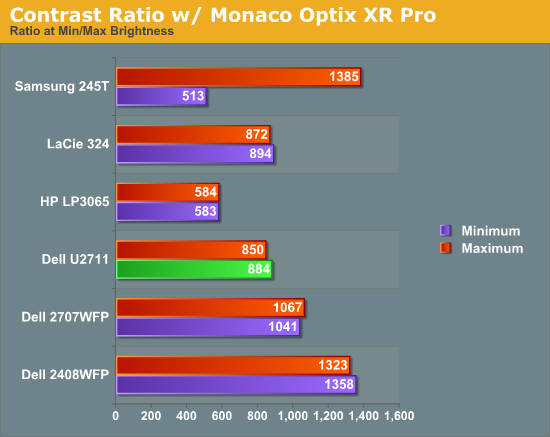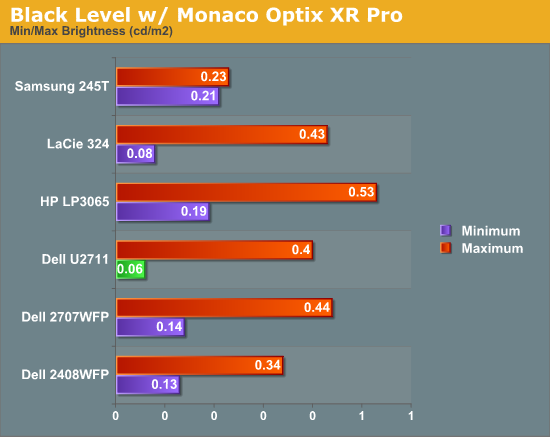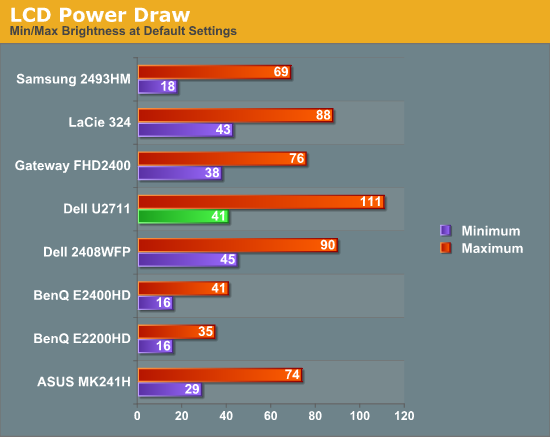Dell UltraSharp U2711: Quality has a Price
by Jarred Walton on January 22, 2010 2:00 AM EST- Posted in
- Displays
Brightness and Contrast
For the brightness, contrast, and color accuracy tests, we depend on a hardware colorimeter and software to help calibrate the displays. We use a Monaco Optix XR (DTP-94) colorimeter and Monaco Optix XR Pro software. Dell advertises a typical contrast ratio of 1000:1 and a maximum contrast (using dynamic backlight adjustment) of 80000:1. We're not interested in dynamic contrast, so we used the Adobe RGB setting for the results below. For those that are wondering, the reason we don't like dynamic contrast is that CCFL backlights take time to settle in and provide a consistent output, and if a display is constantly modifying the backlight level you won't get accurate colors.



Don't pay too much attention to the white/black graphs, as they are merely reference points for how the displays perform at certain settings. Like many other LCDs, the U2711 has a "normal" brightness level of around 260nits (the Adobe RBS setting defaults to 50% brightness and contrast), which is more than sufficient and is actually brighter than what most users prefer to use in an office environment. You can reach the advertised 350nits (give or take) if you max out brightness and contrast.
We're more interested in the contrast ratio, and here we find that the U2711 doesn't quite reach the advertised 1000:1 but instead comes closer to 850:1. We would have liked to see black levels a bit lower to improve the contrast, but really anywhere above 750:1 is difficult to see the difference, and 500:1 is sufficient for most users. At lower brightness settings, the contrast ratio improves to the point where our 100nits "print" result (~13% brightness) actually reached the advertised 1000:1 contrast ratio.
Power Requirements
Going along with the brightness levels, here are the power requirements we measured at the Windows desktop using the minimum brightness (53nits) setting along with 100nits (13%), 200nits (36%), and maximum brightness (340nits).

This is another area where we think the U2711 could be improved, but the cost might be too high right now. CCFL backlighting has been the norm since LCDs first came out, and it works but it's not the most power efficient way of lighting up an LCD. LEDs are the new and improved method, but while they can save power they also tend to deliver a lower color gamut. RGB LEDs address that shortcoming but they cost more and appear to use a similar amount of power compared to CCFL (and we've only seen them used in laptops so far). The U2711 draws a minimum of 41W, but a more realistic setting of 200nits will pull 72W. At maximum brightness the display settles down to 111W, but we measured a peak draw of 124W. (When we first cranked up brightness from 36% to 100%, brightness also reached 390nits before declining to 340nits.) We'd like to see LCDs that deliver all the color quality at half the power draw, but right now it's more a question of priorities: if you go green on power, your green colors may end up lacking. And to keep things in perspective, 72W at 200nits for a 27" LCD is still about half the power of your typical 21/22" CRT running at ~200nits!










153 Comments
View All Comments
Hxx - Saturday, January 23, 2010 - link
if you need anything bigger than a 24 inch for gaming youre better off with a nice led or lcd tv (40 inch or so is perfect) hook up your machine to it and youre in business. seems rather pointless to spend that much money for a monitor unless youre using it for something other than games/movies.FlyTexas - Sunday, January 24, 2010 - link
Yuck...Who wants a 32" LCD running at 1280x720 2 feet in front of you?
Blah...
Besides, those TVs were meant and designed to be watched from 6-10 ft away, not for close up viewing. Even if you got a 1080P panel, it would still have half the resolution of a 30" desktop LCD (at 2560x1600, it has 4 million pixels compared to 2 million on the 1080P or 1 million on the 720P)
Now, I have seen HDTVs used as computer monitors for wall displays of information in companies, but again those are meant to be viewed 6-10 ft away, not to be put on your desktop.
erple2 - Saturday, January 23, 2010 - link
I think that the GP was referring not to the actual size of the monitor, but the resolution of the monitor. The problem with the LCD or LED TV's is that they run at (at best) 1920x1080 resolution. This screen has substantially higher resolution to it. The dot pitch of those screens are pretty .. terrible in fact.When will people understand the difference between dot pitch and physical screen size?
erple2 - Saturday, January 23, 2010 - link
Also, if you do any kind of image manipulation (Photoshop-style of CAD style) you want a high resolution screen more than a physically large screen. While it's generally true that larger screens have higher resolution, that isn't generally the case. In fact, it reverses the trend once you start going with TV's...evilspoons - Saturday, January 23, 2010 - link
I disagree; the 3008WFP is an older model with slower signal processing and narrower black levels.I bought a U2410, it is amazing, period. You put it in 'game' mode and the input lag drops to ~15 ms, which is one of the best LCDs on the market today. (Check out the review on tftreview.co.uk - no affiliation here except I read their review before I bought my U2410.)
FlyTexas - Sunday, January 24, 2010 - link
Err... Maybe... But you're comparing a $500 24" monitor with a $1,000 30" monitor. Not really in the same league...If you want/need a 24" monitor, that is probably a very good one. If you have never used a 30" monitor, you don't know what you're missing.
To each his own... :)
evilspoons - Tuesday, January 26, 2010 - link
I had a 30" monitor (an LG with an IPS panel) and found it was excellent except for the huge lack of signal processing abilities (no scaler, one input). I also found that playing games on it was inconvenient because I'd actually have to turn my head to see the entire picture at my desk.Anyway, the U2410 is $750 MSRP and the U2710 is $1000 MSRP. Compare apples to apples. It's on sale for $500 off and on, and I expect the U2711 to be on sale in the same manner fairly soon. What I'm saying is the U2410 is excellent for certain things that the U2711 presumably is and the WFP3008/9/whatever isn't. It's not for everyone but I'm offering an alternative.
Zebo - Friday, January 22, 2010 - link
No it wouldnt. It's grainy if you have good eyesight with its huge pixel pitch ~.255 vs . 233 for this model. I wish LCD makers would get below .15 but is a start.rbnn - Friday, March 12, 2010 - link
Hi,Very interesting review, thanks. Still, I am not a monitor expert and just use ordinary apps in Windows 7:
(1) Text - reading web pages (chrome), using Word and PDF (often multiple large text docs open at once);
(2) Blu-ray.
Is the monitor good for these?
I frankly did not understand your comment about smaller dot-pitch being bad. Wouldn't smaller dot pitch be good, as you get crisper text? Being able to see large pdf pages, or multiple ones, at full size on would seem to be helped by smaller dot pitch, not hindered. I just don't understand your comment there. You can always just reset software to magnify if text is too small, is that what you were complaining about?
Griswold - Sunday, January 24, 2010 - link
Bullshit. Get a reality check. Just because it suits YOU, doesnt mean it suits the majority.